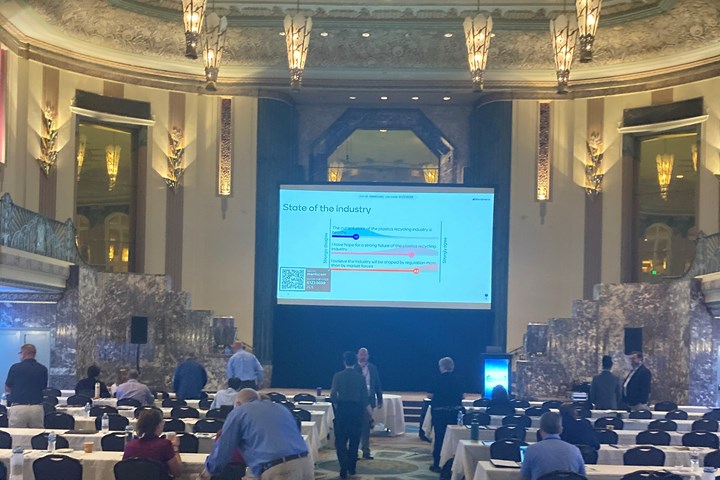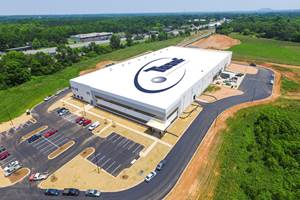Recycling Leaders Meet to Explore Economic and Technical Challenges
Baerlocher hosted its second annual recycling summit, featuring pragmatic discussion covering the entire value chain.
Stakeholders in the plastics recycling market assembled in Cincinnati August 22 & 23 for the second annual Recycling Summit. The diversity of participants spanned production, consumer brand, material conversion, equipment supply, and material recovery. Speakers offered a variety of insights on the looming challenge of increasing the recycled portion of plastics production against the headwind of sluggish prices (pricing for regrind and reprocessed plastics have remained low throughout 2023, according to reports from the ).
Processing Recycled Resin: Challenges and Strategies
Jens Schuelter, of equipment supplier W. Muller, shared results of testing that company does to understand the challenges in processability, appearance, and mechanical properties encountered by their customers, with examples of how formulation changes can help meet specifications—even with PCR materials other than the best quality HDPE.

Recycling leaders met amid uncertainty about economic drivers and policy directions.
Photo Credit: Matt Stonecash
Nate Miranda, of , spoke of the challenges in using recycled material in shrink collation films, where paper labeling, adhesives, varying content, and even inconsistent pellet sizes can create processing issues.
Robert Sherman, technical director at Baerlocher, explained the chemical mechanisms of degradation introduced by recycling processes, and how stabilization can mitigate the effects. “Recycling involves heat and shear, the two worst things you can do to a polymer,” said Sherman. Joe Palmer, of Altium, also attributed much of the difficulty dealing with recycled materials to degradation from heat cycle history. Palmer described analysis and design strategies to prevent common product failure modes.
Price Gap Between Recycled and Virgin Material
Given the amount of work and expertise required to access the value in recycled plastic, it should be no surprise that its production costs more than simply making new virgin plastic. It is not clear where in the value chain that cost can be absorbed in the current environment.
Ben Ma, associate research director at , expressed skepticism that consumers would be willing to pick it up: “People say they will spend more money on a sustainable product. But if you put money in their pocket and send them to the store, you’ll find out what they really buy.”
Greg Janson, president at , and Steve Alexander, president at the (APR), both cited competition from wide-spec virgin resin as a downward pressure on recycled material prices. According to Janson, opportunities in durable goods could help make demand more predictable and prices more competitive in the long term. “We have a viable recycling industry because of durables, not packaging”, said Janson.
Others opined that recycled plastics would never be consistently competitive to virgin material on a cost basis. “The cost of PCR may have been less than virgin at one point, but that was a moment in history. It costs money to recycle,” said Jean Bina, director of sales and market development at .
Despite the challenges, live polling conducted at the summit showed that many participants were optimistic about the future of plastics recycling. Views on extended producer responsibility laws and recycled content mandates were diverse, but the general sentiment was that policy would play an indispensable role in the future of recycling.
Data presented by APR’s Steve Alexander may have been part of the optimism. According to a report , five billion pounds of plastic was recycled in North America in 2021, and 90% of plastic collected for recycling was processed within North America.
Organizers from Baerlocher closed by soliciting feedback on the content of the summit, with the aim of incorporating in its next iteration in 2024.
Related Content
Masterbatches Reduce Gloss in PLA and PETG 3D Printed Products
Insight Polymers & Compounding’s two low-gloss additive masterbatches shown to boost appearance of 3D printed objects.
Read MoreCompatibilizer for Nylon/ABS Alloys
CAI Performance Additives’ ST-AN3230 has shown to improve both compatibility and performance of nylon/ABS alloys.
Read MoreTosaf’s Investments in North America Result in 40% Increase in Production Capacity
Backed by a global presence, Tosaf provides localized additive and color solutions, and services for the plastic industry in North America.
Read MoreBASF Highlighting How They 'Make, Use and Recycle Future Solutions'
NPE2024: BASF is using its proprietary computer-aided engineering tool Ultrasim when designing for sustainability in a broad range of industries.
Read MoreRead Next
Beyond Prototypes: 8 Ways the Plastics Industry Is Using 3D Printing
Plastics processors are finding applications for 3D printing around the plant and across the supply chain. Here are 8 examples to look for at NPE2024.
Read MorePeople 4.0 – How to Get Buy-In from Your Staff for Industry 4.0 Systems
Implementing a production monitoring system as the foundation of a ‘smart factory’ is about integrating people with new technology as much as it is about integrating machines and computers. Here are tips from a company that has gone through the process.
Read More












